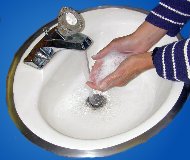
|
 |
Hospital eTool - HealthCare Wide Hazards Module
Infection
Potential Hazard
Exposure of employees to community and nosocomial infections, e.g.,
Multi-Resistant Staph Aureus (MRSA). Nosocomial infections are infections that occur from exposure to infectious organisms found in
facilities such as hospitals. Health care workers are exposed to these organisms and can then become infected and/or become carriers and
spread the infection to other staff and patients.
|
 |
Possible Solutions
- Follow the
Bloodborne Pathogens Standard if exposure to blood or OPIM is anticipated including
universal precautions.
- Use appropriate hand washing.
- According to the CDC appropriate hand washing results in a reduced incidence of both nosocomial and community infections.
Guidelines from national and international infection prevention and control organizations have repeatedly acknowledged that
hand washing is the single most important procedure for preventing infections. Despite this, compliance with
hand washing by health care providers is poor.
- Hand washing with plain soap (detergents) is effective in removing most transient microbial flora. The components
of good hand washing include using an adequate amount of soap, rubbing the hands together to create some friction, and rinsing under
running water. The mechanical action of washing and drying removes most of the transient bacteria present.
- Washing hands as promptly and thoroughly as possible between patient contacts and after contact with blood, body fluids, secretions,
excretions, and equipment or articles contaminated by them is an important component of infection control and isolation precautions.
To help protect exposure to infectious materials, wash your hands:
|
- Before/after work
- Before/after eating
- Before/after smoking
- Before/after using PPE
|

|
- Before/after each patient contact
- Before/after putting in contact lenses
- Before/after using the bathroom
- Before/after applying makeup
|
- Wear gloves: In addition to hand washing, gloves play an important role in reducing the risks of transmission of microorganisms.
- Gloves are worn for three important reasons in hospitals.
- First, gloves are worn to provide a protective barrier and to prevent gross contamination of the hands
when touching blood, body fluids, secretions, excretions, mucous membranes, and non-intact skin; as mandated by the OSHA Bloodborne
Pathogens Standard 1910.1030.
- Second, gloves are worn to reduce the likelihood that microorganisms present on the hands of personnel
will be transmitted to patients during invasive or other patient-care procedures that involve touching a patient's mucous membranes and
non-intact skin.
- Third, gloves are worn to reduce the likelihood that hands of personnel contaminated with microorganisms
from a patient or object can transmit these microorganisms to another patient. In this situation, gloves must be changed between patient
contacts and hands washed after gloves are removed.
- Wearing gloves does not replace the need for hand washing, because gloves may have small, in-apparent defects or may be torn
during use, and hands can become contaminated during removal of gloves. Failure to change gloves between patient contacts is an
infection control hazard.
Hand washing according to the Bloodborne Pathogen Standard:
- Employers must ensure that employees wash hands and any other skin with soap and water or flush mucous membranes with water as
soon as feasible after contact with blood or other potentially infectious materials (OPIM)
[1910.1030(d)(2)(vi)].
- Employers must provide readily accessible hand washing facilities,
[1910.1030(d)(2)(iii)]
and ensure that employees wash their hands immediately or as soon as feasible after removal of gloves
[1910.1030(d)(2)(5)].
- When provision of hand washing facilities is not feasible, the employer shall provide either an appropriate antiseptic hand cleanser
in conjunction with clean cloth/paper towels or antiseptic towelettes. When antiseptic hand cleansers or towelettes are used, hands
shall be washed with soap and running water as soon as feasible
[1910.1030(d)(2)(iv)].
Additional Information:
|
|

